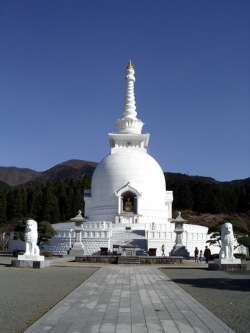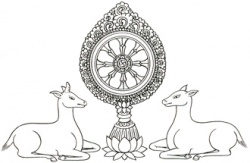Difference between revisions of "The Sutra Pitaka"
(Created page with " <poem> THE SUTRA PITAKA 41.1 The Six Fulfillment 41.2 The Five Nikayas (Agamas) 41.3 The Mahayana Sutra THE SUTRA PITAKA Literally, ...") |
|||
| (3 intermediate revisions by the same user not shown) | |||
| Line 1: | Line 1: | ||
| − | + | {{DisplayImages|76|3466|461|791}} | |
<poem> | <poem> | ||
| − | THE | + | [[THE SUTRA PITAKA]]; ([[Sutra Pitaka]]) |
| − | 41.1 The Six Fulfillment | + | 41.1 The [[Six Fulfillment]] |
41.2 The Five [[Nikayas]] ([[Agamas]]) | 41.2 The Five [[Nikayas]] ([[Agamas]]) | ||
41.3 The [[Mahayana Sutra]] | 41.3 The [[Mahayana Sutra]] | ||
| − | THE SUTRA | + | THE [[SUTRA PITAKA]] |
Literally, [[sutra]] means "[[sacred]] teachings". | Literally, [[sutra]] means "[[sacred]] teachings". | ||
| − | The [[sutra]] comprises [[discourses]] or sermons delivered by the [[Buddha]] at various times and places to his [[disciples]]. It is one of the [[Tripitaka]] (literally the [[Three Baskets]]), the [[canon]] of [[Buddhism]]. The [[Sutra Pitaka]] i.e. "[[Basket of Discourses]]" is [[essential teachings]] of [[Buddhism]]. | + | The [[sutra]] comprises [[discourses]] or [[sermons]] delivered by the [[Buddha]] at various times and places to his [[disciples]]. It is one of the [[Tripitaka]] (literally the [[Three Baskets]]), the [[canon]] of [[Buddhism]]. The [[Sutra Pitaka]] i.e. "[[Basket of Discourses]]" is [[essential teachings]] of [[Buddhism]]. |
| − | 41.1 The Six Fulfillment | + | 41.1 The [[Six Fulfillment]] |
| − | The [[Sutra]] is identified by its format known as the Six Fulfillment's. A [[sutra]] always begins with the words, "[[Thus have I heard]]. At one [[time]] ......." The [[sutra]] was complied by the [[disciple]] who recited from [[memory]] all the sermons in the [[First Council]] soon after the [[death]] of the [[Buddha]]. Therefore, The Six Fulfillment's are indication that it is the true record of the [[teaching]] given by the [[Buddha]], and the words were coming out directly from the [[Buddha]]. Taking an example, the [[Diamond Sutra]] (or called the [[Vajra | + | The [[Sutra]] is identified by its format known as the [[Six Fulfillment's]]. A [[sutra]] always begins with the words, "[[Thus have I heard]]. At one [[time]] ......." The [[sutra]] was complied by the [[disciple]] who recited from [[memory]] all the [[sermons]] in the [[First Council]] soon after the [[death]] of the [[Buddha]]. Therefore, The [[Six Fulfillment's]] are indication that it is the true record of the [[teaching]] given by the [[Buddha]], and the words were coming out directly from the [[Buddha]]. Taking an example, the [[Diamond Sutra]] (or called the [[Vajra Paramita Sutra]]) begins with: |
"Thus" - the fulfillment of requirement on [[belief]]. | "Thus" - the fulfillment of requirement on [[belief]]. | ||
| Line 21: | Line 21: | ||
"At one [[time]]" - the fulfillment of requirement on [[time]]. | "At one [[time]]" - the fulfillment of requirement on [[time]]. | ||
"The [[Buddha]]" - the fulfillment of requirement on the host, i.e. speaker. | "The [[Buddha]]" - the fulfillment of requirement on the host, i.e. speaker. | ||
| − | In [[Sravasti]] in the [[Jeta Grove]] of the Garden - the fulfillment of requirement on place. | + | In [[Sravasti]] in the [[Jeta Grove]] of the [[Garden]] - the fulfillment of requirement on place. |
Together with a [[gathering]] of great [[Bhiksus]], twelve hundred fifty in all - the fulfillment of requirement on audiences. | Together with a [[gathering]] of great [[Bhiksus]], twelve hundred fifty in all - the fulfillment of requirement on audiences. | ||
| Line 38: | Line 38: | ||
[[Majjhima Nikaya]] (in [[Pali]], [[Madhyamagama]] in [[Sanskrit]]) | [[Majjhima Nikaya]] (in [[Pali]], [[Madhyamagama]] in [[Sanskrit]]) | ||
| − | "Collection of Grouped | + | "[[Collection of Grouped Discourses]]" |
152 [[sutras]] subdivided into 15 groups. ([[Vaggas]]) | 152 [[sutras]] subdivided into 15 groups. ([[Vaggas]]) | ||
[[Samyutta Nikaya]] (in [[Pali]], [[Samyuktagama]] in [[Sanskrit]]) | [[Samyutta Nikaya]] (in [[Pali]], [[Samyuktagama]] in [[Sanskrit]]) | ||
| − | "Collection of Grouped | + | "[[Collection of Grouped Discourses]]" |
5 groups subdivided into 56 more groups. | 5 groups subdivided into 56 more groups. | ||
[[Anguttara Nikaya]] (in [[Pali]], [[Ekottaragama]] in [[Sanskrit]]) | [[Anguttara Nikaya]] (in [[Pali]], [[Ekottaragama]] in [[Sanskrit]]) | ||
| − | "Collection of | + | "[[Collection of Discourses Treating Enumerations Classed in Ascending Order]]" |
This [[Nikaya]] is named because of the method of arranging the [[sutras]]. The first of eleven groups concerns lists of single things, the second concerns lists of two things, and so on up to the eleventh group. There are lists of eleven things discussed in this [[Nikaya]]. | This [[Nikaya]] is named because of the method of arranging the [[sutras]]. The first of eleven groups concerns lists of single things, the second concerns lists of two things, and so on up to the eleventh group. There are lists of eleven things discussed in this [[Nikaya]]. | ||
| − | [[Khuddaka Nikaya]] (in [[Pali]], Kukkutagama in [[Sanskrit]]) | + | [[Khuddaka Nikaya]] (in [[Pali]], [[Kukkutagama]] in [[Sanskrit]]) |
| − | "Collection of Minor Works" | + | "[[Collection of Minor Works]]" |
There are 15 items in this [[Nikaya]] in [[Theravada]]: | There are 15 items in this [[Nikaya]] in [[Theravada]]: | ||
| − | (1) Kuddaka-patha : The Reading of short Passages. | + | (1) [[Kuddaka-patha]] : The [[Reading of short Passages]]. |
| − | (2) [[Dhammapada]] : [[Stanzas]] or [[Gatha | + | (2) [[Dhammapada]] : [[Stanzas]] or [[Gatha on the Teaching]]. |
| − | (3) [[Udana]] : Solemn Utterances. | + | (3) [[Udana]] : [[Solemn Utterances]]. |
(4) [[Itivuttaka]] : Thus it is Said (from the introductory [[phrase]] to each [[sutra]]). | (4) [[Itivuttaka]] : Thus it is Said (from the introductory [[phrase]] to each [[sutra]]). | ||
| − | (5) Sutra-nipata : Collection of [[Sutras]]. | + | (5) [[Sutra-nipata]] : Collection of [[Sutras]]. |
| − | (6) Vimana-vatthu : Stories About [[Heavenly]] {{Wiki|Palaces}}. | + | (6) [[Vimana-vatthu]] : Stories About [[Heavenly]] {{Wiki|Palaces}}. |
(7) [[Peta-vatthu]] : Stories About [[Hungry Ghosts]]. | (7) [[Peta-vatthu]] : Stories About [[Hungry Ghosts]]. | ||
| − | (8) Thera-gatha : [[Verses of the Elders]]. | + | (8) [[Thera-gatha]] : [[Verses of the Elders]]. |
| − | (9) Theri-gatha : Verses of the | + | (9) [[Theri-gatha]] : [[Verses of the Nuns]]. |
| − | (10) [[Jataka]] : Previous [[Lives | + | (10) [[Jataka]] : Previous [[Lives of the Buddha]]. |
(11) [[Niddesa]] : [[Exposition]]. | (11) [[Niddesa]] : [[Exposition]]. | ||
| − | (12) Patisambhida-magga : | + | (12) [[Patisambhida-magga]] : The Way of Analysis. |
(13) [[Apadana]] : Verse Accounts of the [[Lives]] of Certain [[Monks and Nuns]]. | (13) [[Apadana]] : Verse Accounts of the [[Lives]] of Certain [[Monks and Nuns]]. | ||
(14) [[Buddhavamsa]] : The [[Lineage]] of the [[Buddha]]. | (14) [[Buddhavamsa]] : The [[Lineage]] of the [[Buddha]]. | ||
| − | (15) Cariya-pitaka : Collection Concerning Conduct. | + | (15) [[Cariya-pitaka]] : Collection Concerning Conduct. |
The first four [[Nikayas]] are [[recognized]] by all the [[early schools]], but the fifth is found only in [[Pali]] and not in the {{Wiki|Chinese}} translations. However, some [[sutras]], such as [[Dharmapada]] [[exist]] in {{Wiki|Chinese}} as separate [[scripture]] of other [[Agamas]]. In general, the [[sutras]] compared in [[early Buddhism]] are in [[Pali]], representing the [[Theravada tradition]], which is perhaps the only one [[form]] of [[Hinayana Buddhism]] nowadays. | The first four [[Nikayas]] are [[recognized]] by all the [[early schools]], but the fifth is found only in [[Pali]] and not in the {{Wiki|Chinese}} translations. However, some [[sutras]], such as [[Dharmapada]] [[exist]] in {{Wiki|Chinese}} as separate [[scripture]] of other [[Agamas]]. In general, the [[sutras]] compared in [[early Buddhism]] are in [[Pali]], representing the [[Theravada tradition]], which is perhaps the only one [[form]] of [[Hinayana Buddhism]] nowadays. | ||
| Line 77: | Line 77: | ||
41.3 The [[Mahayana Sutra]] | 41.3 The [[Mahayana Sutra]] | ||
| − | However, there are [[Mahayana sutras]], which are probably composed over a period of several hundred years, as new [[insights]] developed in [[Mahayana]]. Presumably, the first [[Mahayana sutra]] is [[Prajna paramita | + | However, there are [[Mahayana sutras]], which are probably composed over a period of several hundred years, as new [[insights]] developed in [[Mahayana]]. Presumably, the first [[Mahayana sutra]] is [[Prajna paramita sutra]]. Many other [[sutras]] are developed to expound the [[nature]] of a [[Buddha]], the career of [[Bodhisattvas]], the [[Wikipedia:concept|concepts]] of [[emptiness]], the [[doctrine]] of [[Middle Way]], etc., e.g. |
The [[Prajnaparamita Sutra]] ("[[Sutra]] on [[Wisdom]]") | The [[Prajnaparamita Sutra]] ("[[Sutra]] on [[Wisdom]]") | ||
The [[Saddharmapundarika Sutra]] ("The [[Wonderful Dharma Lotus Flower Sutra]]"). | The [[Saddharmapundarika Sutra]] ("The [[Wonderful Dharma Lotus Flower Sutra]]"). | ||
The [[Avatamsaka Sutra]] | The [[Avatamsaka Sutra]] | ||
| − | ("[[Flower | + | ("[[Flower Adnornment Sutra]]") |
The [[Amitabha Sutra]]. | The [[Amitabha Sutra]]. | ||
Latest revision as of 10:26, 9 March 2015
THE SUTRA PITAKA; (Sutra Pitaka)
41.1 The Six Fulfillment
41.2 The Five Nikayas (Agamas)
41.3 The Mahayana Sutra
THE SUTRA PITAKA
Literally, sutra means "sacred teachings".
The sutra comprises discourses or sermons delivered by the Buddha at various times and places to his disciples. It is one of the Tripitaka (literally the Three Baskets), the canon of Buddhism. The Sutra Pitaka i.e. "Basket of Discourses" is essential teachings of Buddhism.
41.1 The Six Fulfillment
The Sutra is identified by its format known as the Six Fulfillment's. A sutra always begins with the words, "Thus have I heard. At one time ......." The sutra was complied by the disciple who recited from memory all the sermons in the First Council soon after the death of the Buddha. Therefore, The Six Fulfillment's are indication that it is the true record of the teaching given by the Buddha, and the words were coming out directly from the Buddha. Taking an example, the Diamond Sutra (or called the Vajra Paramita Sutra) begins with:
"Thus" - the fulfillment of requirement on belief.
"I have heard" - the fulfillment of requirement on hearing.
"At one time" - the fulfillment of requirement on time.
"The Buddha" - the fulfillment of requirement on the host, i.e. speaker.
In Sravasti in the Jeta Grove of the Garden - the fulfillment of requirement on place.
Together with a gathering of great Bhiksus, twelve hundred fifty in all - the fulfillment of requirement on audiences.
This is the "common preface" of all Sutras.
The sutras are dogmatic, which is the truth discovered by the Buddha in his enlightenment. Sutras are written in various figures of speech, chiefly simile and metaphor.
41.2 The Five Nikayas (Agamas)
There are five Nikayas ("collection of sutras", also call Agamas). The outline is as follows:
Digha Nikaya (in Pali, Dirghagama in Sanskrit)
"Collection of Long Discourses"
34 long sutras subdivided into 3 groups. (Vaggas)
Majjhima Nikaya (in Pali, Madhyamagama in Sanskrit)
"Collection of Grouped Discourses"
152 sutras subdivided into 15 groups. (Vaggas)
Samyutta Nikaya (in Pali, Samyuktagama in Sanskrit)
"Collection of Grouped Discourses"
5 groups subdivided into 56 more groups.
Anguttara Nikaya (in Pali, Ekottaragama in Sanskrit)
"Collection of Discourses Treating Enumerations Classed in Ascending Order"
This Nikaya is named because of the method of arranging the sutras. The first of eleven groups concerns lists of single things, the second concerns lists of two things, and so on up to the eleventh group. There are lists of eleven things discussed in this Nikaya.
Khuddaka Nikaya (in Pali, Kukkutagama in Sanskrit)
"Collection of Minor Works"
There are 15 items in this Nikaya in Theravada:
(1) Kuddaka-patha : The Reading of short Passages.
(2) Dhammapada : Stanzas or Gatha on the Teaching.
(3) Udana : Solemn Utterances.
(4) Itivuttaka : Thus it is Said (from the introductory phrase to each sutra).
(5) Sutra-nipata : Collection of Sutras.
(6) Vimana-vatthu : Stories About Heavenly Palaces.
(7) Peta-vatthu : Stories About Hungry Ghosts.
(8) Thera-gatha : Verses of the Elders.
(9) Theri-gatha : Verses of the Nuns.
(10) Jataka : Previous Lives of the Buddha.
(11) Niddesa : Exposition.
(12) Patisambhida-magga : The Way of Analysis.
(13) Apadana : Verse Accounts of the Lives of Certain Monks and Nuns.
(14) Buddhavamsa : The Lineage of the Buddha.
(15) Cariya-pitaka : Collection Concerning Conduct.
The first four Nikayas are recognized by all the early schools, but the fifth is found only in Pali and not in the Chinese translations. However, some sutras, such as Dharmapada exist in Chinese as separate scripture of other Agamas. In general, the sutras compared in early Buddhism are in Pali, representing the Theravada tradition, which is perhaps the only one form of Hinayana Buddhism nowadays.
41.3 The Mahayana Sutra
However, there are Mahayana sutras, which are probably composed over a period of several hundred years, as new insights developed in Mahayana. Presumably, the first Mahayana sutra is Prajna paramita sutra. Many other sutras are developed to expound the nature of a Buddha, the career of Bodhisattvas, the concepts of emptiness, the doctrine of Middle Way, etc., e.g.
The Prajnaparamita Sutra ("Sutra on Wisdom")
The Saddharmapundarika Sutra ("The Wonderful Dharma Lotus Flower Sutra").
The Avatamsaka Sutra
("Flower Adnornment Sutra")
The Amitabha Sutra.
Many Mahayana Sutras are related to numerous Buddhas and Bodhisattvas in the Dharma Realms.



